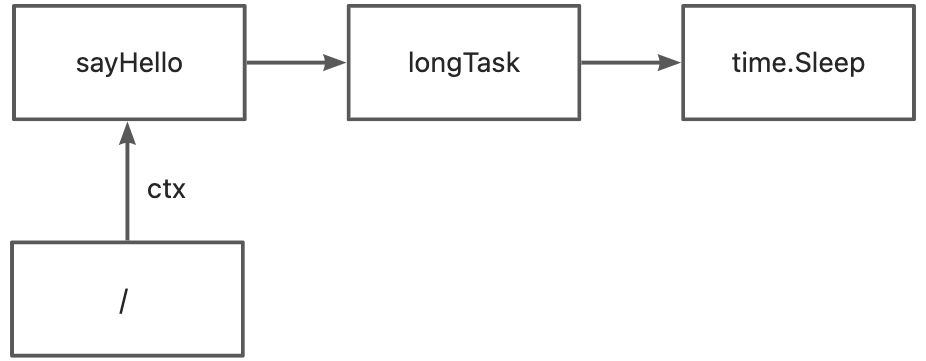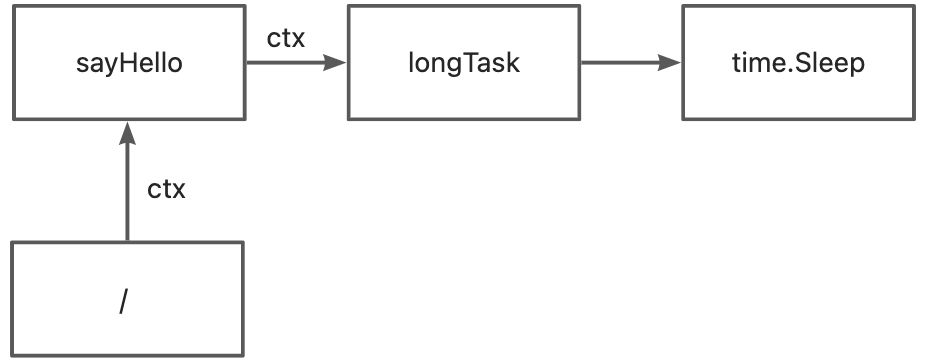通过http库控制请求超时来一窥context的使用
相信很多人对于golang中的context 都有一定的了解,都知道它是一个上下文管理,有一个根context, 再通过这个根context 创建出有更多功能的context, 如具有cancel 功能的,有timeout功能的。 我们搜索的时候,我们可能看到最多的就是以下的代码
package main
import (
"context"
"fmt"
"sync"
"time"
)
func work(ctx context.Context, wg *sync.WaitGroup) {
defer wg.Done()
for {
select {
case <-ctx.Done():
fmt.Println("ctx 被取消了")
return
default:
fmt.Println("I am working")
time.Sleep(1 * time.Second)
}
}
}
func main() {
wg := sync.WaitGroup{}
ctx := context.Background()
ctx, cancel := context.WithCancel(ctx)
wg.Add(1)
go work(ctx, &wg)
time.Sleep(3 * time.Second)
cancel()
wg.Wait()
fmt.Println("main process end!")
}
创建一个带有取消功能的ctx,然后用于控制协程里的执行过程。当协程里的select 不停的检查这个ctx是否被取消了,如果取消了,则协程也结束。
可是我一直在想一个问题,这样的玩具代码虽然可以说明ctx的作用,但是真实的项目中我们真的是这么用ctx的吗? 在介绍ctx时,都会说ctx可以穿梭于协程之间, 一个协程创建了n个子协程,n个子协程又会创建m个孙协程,我们可以将一个带有cancel 功能的ctx挂在每个协程上,这样只要调用这个ctx则所有的协程都会结束。
可是道理都懂,该如何写出具有这种效果的代码呢?
比如我们写了一个http的服务
package main
import (
"fmt"
"net/http"
)
func SayHello(w http.ResponseWriter, r *http.Request) {
fmt.Println("visit SayHello")
n, err:=w.Write([]byte(string("hello world")))
fmt.Printf("send %d bytes\n", n)
if err!=nil{
fmt.Println(err)
}
}
func main() {
http.HandleFunc("/", SayHello)
http.ListenAndServe("127.0.0.1:8000", nil)
}
代码很简单,当访问 http://127.0.0.1:8000/时会返回 hello world ,服务端打印出
visit SayHello
send 11 bytes
但是我们现在考虑一个问题,这个SayHello 方法处理的太快的,客户端很快的就能得到结果,但是如果它是一个响应非常慢的函数,如需要处理5秒钟,如访问数据库,在做一些计算什么的,此时如果客户端等不及了,关掉浏览器了,这时会发生什么? 我们改下代码
func SayHello(w http.ResponseWriter, r *http.Request) {
fmt.Println("visit SayHello")
time.Sleep(5 * time.Second) // 模拟长时间操作
n, err := w.Write([]byte(string("hello world")))
fmt.Printf("send %d bytes\n", n)
if err != nil {
fmt.Println(err)
}
}
这时我们再次访问该地址,但是我们不等它返回结果,就关闭浏览器,或者使用curl 访问时,按ctrl+c 结束,这时在服务端依然还是可以得到上面的结果,也就说明,当调用SayHello 函数时,这个函数并没有意识到客户端已经关闭了,还在傻傻的进行处理。
作为服务端,当然是希望可以意识到客户端已经关闭了,这样它就不用再傻傻地进行接下来的计算工作。
这时我们就可以利用context 来检查客户端是否关闭了,http.Request结构体中有个ctx,这个就可以感知客户端是否已经关闭。 我们再改下代码
func SayHello(w http.ResponseWriter, r *http.Request) {
fmt.Println("visit SayHello")
ctx := r.Context()
select {
case <-ctx.Done():
fmt.Println("client closed....")
case <-time.After(5 * time.Second):
n, err := w.Write([]byte(string("hello world")))
fmt.Printf("send %d bytes\n", n)
if err != nil {
fmt.Println(err)
}
}
}
经过上面的代码,当客户端关闭了以后,在select流程中就会走到case <-ctx.Done() 流程,这样就不会走time.After流程,这样我们就做到了服务端可以意识到客户端关闭的效果。
以为这样就完了吗? 显然太简单了!
time.After()也只是一个玩具代码,它其实什么都没有做,只是瞎等了5秒钟,但是这个函数其实也是执行了,也是返回了,只是在流程上并没有执行它的结果而已,我们可以将time.After想象一个实际的操作,如果数据库查询,文件操作等耗时操作.
type longtask struct {
C chan string
}
func (l longtask) longTask() {
fmt.Println("long task start")
time.Sleep(5 * time.Second)
fmt.Println("long task stop")
l.C <- "hello wrold"
}
func SayHello(w http.ResponseWriter, r *http.Request) {
fmt.Println("visit SayHello")
ctx := r.Context()
lt := longtask{C: make(chan string)}
go lt.longTask()
select {
case <-ctx.Done():
fmt.Println("client closed....")
case <-time.After(6 * time.Second):
fmt.Println("req timeout")
case s := <-lt.C:
n, err := w.Write([]byte(s))
fmt.Printf("send %d bytes\n", n)
if err != nil {
fmt.Println(err)
}
}
}
上面的代码,将之前的time.After改为一个具体的具体的函数longTask, 此时如果因为是通过 go longTask()方式调用,相当于又启了一个子协程,现在服务端打印出
visit SayHello
long task start
client closed....
long task stop
也就是longTask中的函数还是全部执行了,虽然sayHello 函数中可以实现客户端关闭它就结束,但是通过sayHello 启的协程还是意识不到。 现在的调用链为

其中,http.Request中的ctx 只在sayHello 中,并没有传到longTask中,所以如果想要longTask中也跟着客户端的关闭而关闭,则需要将ctx传到longTask中,并且使用selct 进行监听
修改一下longTask的实现, 在main函数调用的时候,把ctx也传过去。
func (l longtask) longTask(ctx context.Context) {
fmt.Println("long task start")
select {
case <-ctx.Done():
fmt.Println("in longtask receive stop")
case <-time.After(5 * time.Second):
fmt.Println("long task stop")
l.C <- "hello wrold"
}
}
func main(){
...
...
go lt.longTask(ctx)
...
...
}
这时longTask 函数就可以自动关闭了。
细心的你可能又发现了, 你这种实现这不又回到最开始的time.Sleep 了吗? 是的,现在其实本质上又回到了最开始的状态了。

上面的代码我们可以将其简化,其实只需要最后一调用的那个函数进行select判断即可
package main
import (
"context"
"fmt"
"net/http"
"time"
)
type longtask struct {
C chan string
}
func (l longtask) longTask(ctx context.Context) string {
fmt.Println("long task start")
select {
case <-ctx.Done():
fmt.Println("long task receive stop msg")
return ""
case <-time.After(5 * time.Second):
fmt.Println("long task stop")
return "hello wrold"
}
}
func SayHello(w http.ResponseWriter, r *http.Request) {
fmt.Println("visit SayHello")
ctx := r.Context()
lt := longtask{C: make(chan string)}
result := lt.longTask(ctx)
if ctx.Err() != nil {
fmt.Println(ctx.Err())
} else {
w.Write([]byte(result))
}
// 以下的select 就可以不用了
// select {
// case <-ctx.Done():
// fmt.Println("client closed....")
// case <-time.After(6 * time.Second):
// fmt.Println("req timeout")
// case s := <-lt.C:
// n, err := w.Write([]byte(s))
// fmt.Printf("send %d bytes\n", n)
// if err != nil {
// fmt.Println(err)
// }
// }
}
func main() {
rdb.Ping(context.Background())
http.HandleFunc("/", SayHello)
http.ListenAndServe("127.0.0.1:8000", nil)
}
这也是很多第三方库第一个参数是个ctx的原因, 有了这个ctx, 我们只需要最后判断一个该ctx.Err 是否为空即可,在ctx传递的过程中,只需要最后调用的函数进行select 即可。
总结
要使用ctx 需要满足以后几点
- ctx 需要在协程和其子协程中传递
- 在调用链的最后需要使用select 进行判断